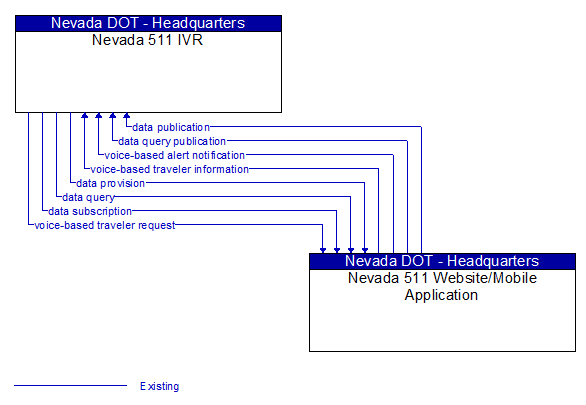Interface: Nevada 511 IVR - Nevada 511 Website/Mobile Application

Architecture Flow Definitions
data provision (Existing) Applicable ITS Standards
Data provision provides the source material for a publish–subscribe or query–retrieval data distribution scheme. This is the 1 of the 1:N data distribution architecture. This flow is a super–flow; it does not define data elements but is inclusive of any flow implemented using publish–subscribe or query–retrieval methods.
data publication (Existing) Applicable ITS Standards
Data publication includes those dialogs necessary to satisfy the publication portion of a data distribution architecture. The information content varies widely based on available content and the subscription, but it generally includes information on the state of transportation system operations including traffic and road conditions, advisories, incidents, transit service information, weather information, parking information, and other related data.
data query (Existing) Applicable ITS Standards
Data query includes those dialogs necessary to determine what data is available for and also submit a query for near–term response.
data query publication (Existing) Applicable ITS Standards
Data query publication includes those dialogs necessary to satisfy the response portion of a query–response action using the data distribution architecture. The information content varies widely based on available content and the query, but it generally includes information on the state of transportation system operations including traffic and road conditions, advisories, incidents, transit service information, weather information, parking information, and other related data.
data subscription (Existing) Applicable ITS Standards
Data subscription includes those dialogs necessary to determine what data is available for subscription/query, and also the dialogs necessary to create or modify data subscriptions/queries.
voice-based alert notification (Existing) Applicable ITS Standards
Information to be distributed to the traveling public via voice regarding a major emergency such as a natural or man–made disaster, civil emergency, severe weather or child abduction. The flow may identify the alert originator, the nature of the emergency, the geographic area affected by the emergency, the effective time period, and information and instructions necessary for the public to respond to the alert. The content of this architecture flow may be specially formatted for voice–based traveler information.
voice-based traveler information (Existing) Applicable ITS Standards
Traveler information sent to the telecommunications systems for traveler information terminator. This flow may represent the bulk transfer of traveler information, including traffic conditions, incident information, transit information and weather and road condition information. It may be specially formatted for voice–based traveler information.
voice-based traveler request (Existing) Applicable ITS Standards
The electronic traveler information request from the telecommunications systems for traveler information terminator. It may be specifically formatted for voice–based traveler requests. The request can be a general subscription intended to initiate a continuous or regular data stream or a specific request intended to initiate a one–time response from the recipient.